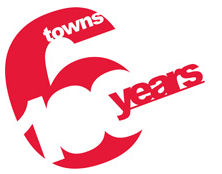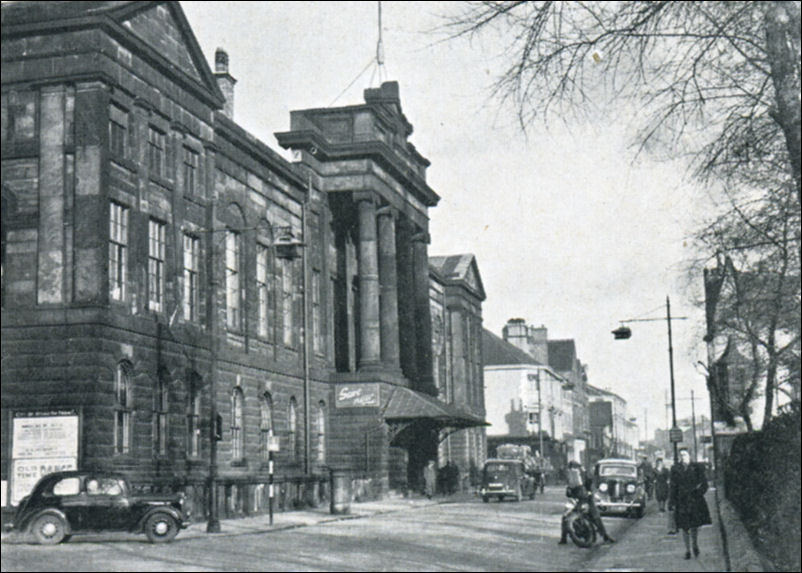![]()
|
|
|
|
|
Stoke-on-Trent - photo of the week |
Advert of the Week
Potworks of the Week
Stoke -
The Town Hall

|
Scenes in the Six Towns "It is natural that to some extent the six towns now federated as the city of Stoke-on-Trent should have their independent lives and local associations existing side by side with their corporate life and wider civic associations. Here then is a short special reference to each Pottery-town." 1947 City of Stoke-on-Trent Official Handbook |

Stoke - The Town Hall
c.1947
|
|
Stoke in 1828 "STOKE-UPON-TRENT, as its name implies, is pleasantly situated upon that river, in an extensive and populous parish, to which it gives name, about one mile and a half east of Newcastle, upon the sides of the Grand Trunk canal. The town contains many handsome houses, wharfs, warehouses and earthenware manufactories, and is deemed the parish town of the potteries. The church, which is and ancient building of stone, will be taken down when the new edifice, which is erecting under the auspices of the parliamentary commissioners, shall be perfected. The church contains a handsome monument to the memory of the late Josiah Wedgwood who was interred here in 1795. In 1815 a very handsomer and commodious national school, for the education of five hundred children was erected at this place, at the cost of nearly £1,000, chiefly raised by subscription. Here are also two meeting houses for dissenters. The first steam engine for grinding burned flint for the use of the potters was established here. About mid-way between Stoke and Newcastle is 'Cliffe vill' the seat of John Tomlinson, Esq; and at Penkhull is 'the Mount,' the seat of Josiah Spode, Esq. The market is Saturday and a wake is held the first Sunday in August annually. The whole parish of Stoke, by the returns for 1821, contained 29,223 inhabitants; and the parish, exclusive of its several extensive dependencies, 3,969 of that number." Pigot & Co's 1828/9 Directory of Staffordshire
Stoke in 1907 (3 years before federation) "Though its population does not exceed 35,000, Stoke-on-Trent is known by name all over the world, and it is a town of -considerable importance in the Potteries. It owes its wide reputation principally to- the fact that some of the finest pottery obtainable is made within its borders. Its local importance is due to many circumstances. It is the railway centre of the whole North Staffordshire district. The N.S. Railway Company have here their headquarters, and while all local trains radiate from Stoke, the London and North Western expresses from London to Manchester call at its busy station. Then it is also the centre of the extensive postal district of Stoke-on-Trent. It gives its name to the Parliamentary borough which also embraces Longton and Fenton; and to the Poor Law Union in which Hanley and the two towns already mentioned are comprised; while organisations covering the whole of North Staffordshire, such as the Chamber of Commerce, the Institute of Mining and Mechanical Engineers, &c, generally meet at the N.S. Hotel, which is probably the principal hotel in the Potteries. Again, Stoke is a place of prominence in connection with ecclesiastical matters, and in this respect has an interesting history. It formed the centre of a huge parish which embraced practically all North Staffordshire and out of which a very large number of parishes have been created. The parish church is an imposing building standing in a spacious churchyard (which is no longer used for burials, and forms a valuable open space). It was erected in the reign of Geo. IV. at an expense of £14,000. Contributions to this large sum were received from all classes, from the Sovereign down to the workingman. The living is a rectory, and has been held by some noble churchmen, to whom Preb. H. V. Stuart, the present holder, is a worthy successor. The business part of Stoke is very compact, but can only be reached from the Railway Station by rather circuitous routes. There is direct tramway communication from this part of the borough with Hanley in one direction; Fenton and Longton in another; Newcastle in another; and Trentham in another. At the spot where these lines meet – Campbell Place - there is a statue of Colin Minton Campbell, who was a honoured citizen of Stoke; and the town possesses two other monuments - a statue in the Station Square of Josiah Wedgwood, the great potter, whose remains are buried in Stoke Churchyard; and a monument on the canal side down London Road to the memory of a tramway employee who lost his life in attempting to rescue a child from drowning. Stoke has pleasant suburbs. Hartshill, Basford and Penkhull (all within the borough) have lofty situations and are residential districts; Oakhill is rapidly assuming the same character. At Hartshill the N.S. Infirmary and The Mount Blind and Deaf School are located. Amongst the possessions of the Corporation are an excellent Town Hall, where the municipal business is conducted; several elementary schools, a Science and Art Institute, and education offices; a Free Library and Museum; Public Baths; a couple of Recreation Grounds (not yet laid out); a beautiful Cemetery; remunerative Markets (where business is principally done on Saturdays); valuable Gas Works; and an Electrical Undertaking which is worked in conjunction with a Refuse Destructor and promises to become a very valuable property. Stoke is the sports centre of the Potteries. It runs a, First League football team; the Staffordshire County Cricket ground is to all intents and purposes within the borough; while the principal athletic organisation of the district – the Victoria Athletic Club - holds its meetings at Stoke. The Hippodrome is a pretty and cosy music-hall. Captain Goss commands the Stoke Volunteers."
1907 Staffordshire Sentinel 'Business Reference Guide to The Potteries, Newcastle & District'
|
|
|